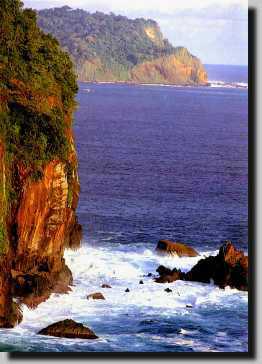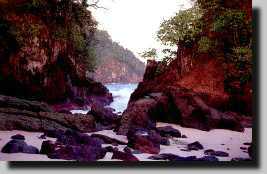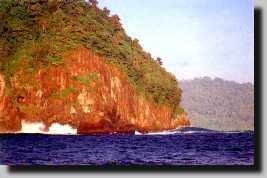
Travel Notes
 Day 3 The weather had
remained good and we awoke to a clear, bright morning. We had
decided to head back to Grajagan early as we still had a lot
of ground to cover on this third and final day in the region.
Nonetheless, there was time for some more exploring and we set
off along the beach in the opposite direction to the one we'd
taken on the previous evening. After a few hundred metres we
came to a small estuary. Fortunately the tide was still low and
had not yet covered up the evidence of pre-dawn activity. Animal
tracks at the water's edge were clearly visible and we could
identify them as deer, wild pig and some kind of large cat. This
led us to recall a conversation with one of the Australian surfers
the previous evening. He had shown us a photograph which a friend
of his had taken at the same estuary. It showed a human foot
beside an extremely large paw mark in the sand, which hewas certain
could only be the track of a tiger. Day 3 The weather had
remained good and we awoke to a clear, bright morning. We had
decided to head back to Grajagan early as we still had a lot
of ground to cover on this third and final day in the region.
Nonetheless, there was time for some more exploring and we set
off along the beach in the opposite direction to the one we'd
taken on the previous evening. After a few hundred metres we
came to a small estuary. Fortunately the tide was still low and
had not yet covered up the evidence of pre-dawn activity. Animal
tracks at the water's edge were clearly visible and we could
identify them as deer, wild pig and some kind of large cat. This
led us to recall a conversation with one of the Australian surfers
the previous evening. He had shown us a photograph which a friend
of his had taken at the same estuary. It showed a human foot
beside an extremely large paw mark in the sand, which hewas certain
could only be the track of a tiger.
Since the official number of Javanese tigers remaining in the
wild is thought to be no ma than about five, and these are only
to be found in the Meru Betiri National Park some distance away,
this information was very exciting. Further more, our friend
told us, there had been a number of recent sightings of tigers
by surfers, the latest being a report by an American couple who
had seen a pair of the animals just a few months back.
Meru Betiri was, in fact, our next destination Located further
west along the south coast, this 50,000 hectare reserve shows
quite different conditions to those found at South Banyuwangi
Whereas the former is comparatively dry an flat, Meru Betiri
is hilly and has a higher average rainfall than most of the surrounding
area. There are still pockets of true tropical rain fores and
some of the more exotic plants to be fount there include the
Rafflesia Zollingeriana (L. and Balanophora Fungosa (L.), both
of which are no longer conserved anywhere else. As to fauna,
there are wild pigs, muncak deer, squir rels, civet cats, black
panthers, leopards and leaf monkeys, to name a few. There are
sea and shore birds, such as egrets and terns, as, well as two
species of hornbill.
Then there is the almost extinct Javanese tiger (panthera tigris
sondaica L.). Estimates of the numbers of this species remaining
range from three to about eight, yet no one is really certain.
An intensive study in 1978 concluded that there were between
three and five, and in 1981 the footprints of a large male were
identified. Sadly, however, the general consensus is that this
animal will, before long, become extinct, the chances of its
survival being hampered still more by the fact that the high
rain forest, to where it has been forced to retreat, is a far
from suitable habitat.
Conservation efforts at Meru Betiri are focused largely on the
turtle nesting beaches, of which Sukamade is the most famous.
Five species of turtle are known to lay eggs here. Emerging from
the sea under cover of darkness, usually bet wee about 9 p.m.
and midnight, the turtles crawl slowly up the beach, deposit
their eggs be neat half a metre of sand and return to the water
in process that takes several hours to complete. he number of
the creatures appearing each evening depends largely on the season,
although there tends to be more activity around the time of the
full moon. Wardens at the beach collect the egg shortly after
they are laid and rebury them in; safe place, away from poachers
and from the danger of being eaten by leopards, which may be
seen lurking in anticipation on the edge of the forest.
 |
 |
|
